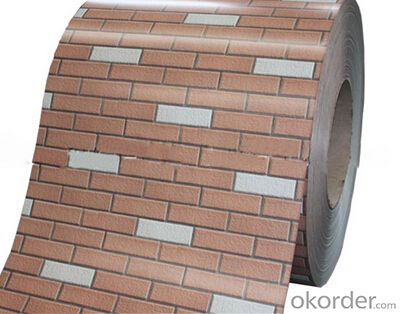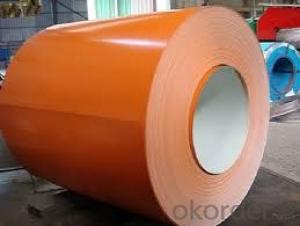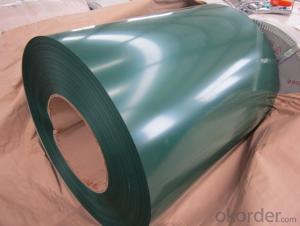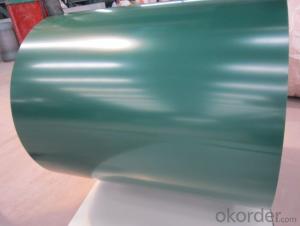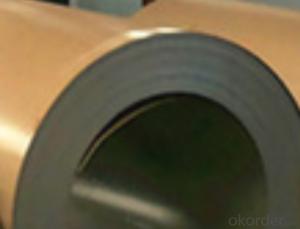Brick Pattern Color Prepainted Steel Coil
- Loading Port:
- Tianjin
- Payment Terms:
- TT OR LC
- Min Order Qty:
- 40 m.t.
- Supply Capability:
- 10000 m.t./month
OKorder Service Pledge
OKorder Financial Service
You Might Also Like
Description:
Model NO.:Brick Pattern
Surface Treatment:Brick Pattern
Certification:ISO, SGS
Technique:Cold Rolled
Standard:ASTM, JIS, GB, AISI, DIN, BS
Application:Ship Plate
Edge:Slit edge
Stock:Stock
Steel Grade:Q195
Thickness:0.18-1.5mm
Export Markets:Global
Additional Info.
Trademark:Dingang/OEM
Packing:Seaworthy Packing, Export Standard
Standard:ISD9001; QS9000
Origin:China
HS Code:72107010
Production Capacity:15 Million Ton/Year
Product Description
Profile
A Color Coated Steel Coil metal has the highest value among all cold-rolled steel products. Produced by printing or baking paints onto the surface of cold-rolled steel or GI or ALCOT sheets, pre-coated metal features a wide range of colors and patterns which are commonly used to make the exterior of buildings and consumer electronics products look more polished and sophisticated. Depending on the specific utility of each product, a vast variety of features are available including pollution resistance and anti-bacterial quality.
Steel grade: CGC, CGCD, CGLCC, CGLCD
Thickness: 0.18-1.5 mm
Width: 30-1250mm, mainly in 914, 1000, 1219, 1250mm.
Surface Finished color: According to RAL standard
Coating Thickness: Min. Single Side coating Thickness: 50 g/sqm
Max. Single Side coating Thickness: 225 g/sqm
Inside diameters: 508 mm
Outside diameter: According to the weight of coil
Weight/coil: 3-8 ton
Packing condition: Seaworthy
Packing weight(without pallet): 25 kgs
Packing weight(with pallet ): 55 kgs


| Coat Type | Dope Type | Coat Thickness (μm) | Rigidity Of Pencil | Shine 60°(%) | Bend | Return Impact(J) | Salt Spray Tolerance(H) | ||||
| High | Middle | Low | Thickness≤0.75mm (Steel window≤0.8 mm) 180°T | Thickness>0.75 mm(Steel window>0.80mm) | |||||||
| A | B | ||||||||||
| Second Coat | PE | ≥20 | ≥F | >70 | 40-70 | <40 | ≤3T | ≤5T | 90° | ≥9 | ≥500 |
| SMP | ≥20 | ≥F | >70 | 40-70 | <40 | ≤3T | ≤5T | 90° | ≥9 | ||
| PVDF | ≥20 | ≥F | -- | 40-70 | <40 | ≤2T | ≤5T | 90° | ≥9 | ≥1000 | |
| Plastisol | ≥100 | -- | -- | 40-70 | <40 | ≤1T | ≤5T | 90° | ≥9 | ||
| First | PE | ≥10 | ≥HB | >70 | 40-70 | <40 | ≤3T | ≤5T | 90° | ≥9 | ≥250 |
- Q: What are the common methods of packaging steel coils for transportation?
- There exists a variety of conventional techniques for packaging steel coils for transportation. One frequently employed approach involves the utilization of steel strapping or bands to fasten the coils together. This method entails tightly encircling the coils with steel bands and securing them using metal buckles or seals. The strapping serves to maintain the coils in position and prevent any shifting or rolling during transportation. Another popular technique entails the use of wooden pallets or skids to stack and transport the steel coils. The coils are positioned onto the pallets and secured with steel strapping or bands. This approach ensures stability and facilitates easy handling and loading onto trucks or other means of transportation. Furthermore, certain steel coils are enclosed within wooden crates or boxes. These crates are typically constructed from robust and durable wood and are designed to shield the coils from external impacts or damage during transportation. To enhance strength and stability, the crates are frequently reinforced with steel bands or strapping. In addition to the aforementioned methods, specialized containers or units are employed to package certain steel coils. These containers are specifically engineered to accommodate and secure steel coils for transportation. They often possess integrated mechanisms or features that facilitate the loading and unloading of the coils in a safer and more efficient manner. It is important to acknowledge that the particular method of packaging steel coils for transportation can vary depending on factors such as the size and weight of the coils, the mode of transportation, and any specific requirements or regulations that may be in effect.
- Q: What are the different types of steel coil loading and unloading methods used during processing?
- There are several different methods used for loading and unloading steel coils during processing. Some common methods include overhead crane lifting, forklift transportation, coil cars, and coil transfer cars. Each method has its own advantages and is chosen based on factors such as the size and weight of the coils, the available equipment, and the layout of the facility.
- Q: What is the maximum width of steel coils?
- The maximum width of steel coils can vary depending on the specific manufacturing processes and equipment capabilities, but it is typically around 72 inches (182.88 cm).
- Q: I am working on a hydrogen generator, but the stainless steel I am using corrodes and turns the water brown. Can anyone tell me if there is stainless steel that does not corrode, and if so, what is it called and where can I get some.Thank you.
- You are not using stainless steel.
- Q: Can steel coils be returned if they are damaged?
- Yes, steel coils can be returned if they are damaged. However, the return policy may vary depending on the supplier or manufacturer. It is important to check the terms and conditions of purchase, including any warranty or guarantee, to understand the specific guidelines for returning damaged steel coils.
- Q: What are the dimensions of steel coils used in the structural component industry?
- The dimensions of steel coils used in the structural component industry can vary depending on the specific application and requirements. However, some common dimensions for steel coils used in this industry include a width ranging from 600mm to 2000mm and a thickness ranging from 0.25mm to 10mm. The weight of these coils can also vary, typically ranging from a few kilograms to several tonnes. Additionally, the length of the steel coils can be customized to meet the specific needs of the structural component industry, with common lengths being 2000mm, 2500mm, and 3000mm. It is important to note that these dimensions are not exhaustive and can vary based on the specific product and manufacturer.
- Q: How are steel coils used in the production of electrical devices?
- The production of electrical devices heavily relies on steel coils. These coils, typically made from high-quality steel, are precisely wound into a circular shape. They have a crucial function in various electrical devices, including transformers, motors, generators, and inductors. Transformers, for instance, heavily rely on steel coils. These devices are essential for adjusting voltage levels in electrical circuits. They consist of two separate coils, the primary and secondary coils, which are wound around a magnetic core. The steel coil plays a vital role in providing stability and support to the windings, ensuring proper alignment and preventing any deformation. Moreover, the high magnetic permeability of steel helps enhance the efficiency of energy transfer between the coils. In motors and generators, steel coils are utilized to create magnetic fields that either generate mechanical energy or convert it into electrical energy. These coils are wound around an armature or rotor, which rotates within a magnetic field created by a stator. As the current flows through the coils, a magnetic field is produced, resulting in the rotation of the armature or the generation of electrical power. Steel coils are also used in inductors, another type of electrical device. Inductors consist of a coil of wire wound around a core material, often made of steel. Steel coils in inductors help increase the inductance, which measures the device's ability to store energy in a magnetic field. By storing energy in this manner, inductors can regulate currents, filter out noise, and provide stability to electrical circuits. All in all, steel coils are indispensable in the production of electrical devices. They provide stability, support, and enhance the necessary magnetic properties for efficient functioning. Without steel coils, the performance and reliability of electrical devices like transformers, motors, generators, and inductors would be greatly compromised.
- Q: Why cold rolled stainless steel sheet is lower than cold rolled stainless steel coil?
- 304 stainless steel coil 2.0*1219*C spot price 18 thousand and 100 / ton, general tolerance at about 1.8mm.Coil price * actual thickness / reference thickness = flat price1.81*1.8/2=16.29
- Q: How are steel coils used in appliances?
- Steel coils are commonly used in appliances for their strength, durability, and heat conductivity. They are primarily utilized in appliances like refrigerators, air conditioners, and ovens to provide efficient cooling and heating functions. The steel coils act as heat exchangers, transferring thermal energy from one area to another, enabling appliances to control and maintain desired temperatures effectively.
- Q: How are steel coils used in the appliance industry?
- Steel coils are used in the appliance industry for a variety of purposes such as manufacturing parts, components, and frames for appliances like refrigerators, washing machines, and ovens. The coils are processed and shaped into specific forms to provide strength, durability, and stability to the appliances.
Send your message to us
Brick Pattern Color Prepainted Steel Coil
- Loading Port:
- Tianjin
- Payment Terms:
- TT OR LC
- Min Order Qty:
- 40 m.t.
- Supply Capability:
- 10000 m.t./month
OKorder Service Pledge
OKorder Financial Service
Similar products
Hot products
Hot Searches
Related keywords


